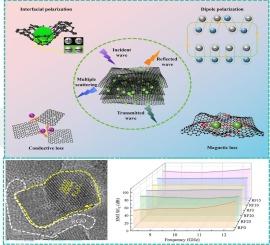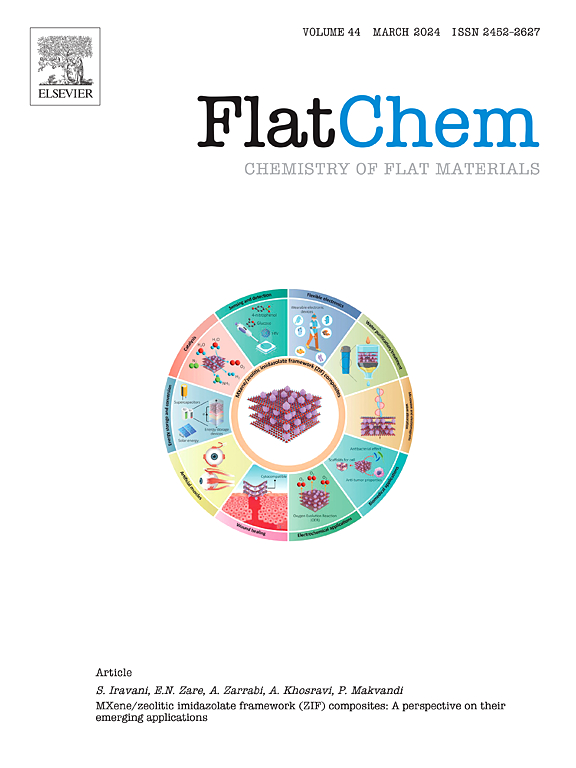In-situ synthesis of RGO/Fe3O4 nanocomposites: Optimizing electromagnetic interference shielding properties
IF 6.2
3区 材料科学
Q2 CHEMISTRY, PHYSICAL
引用次数: 0
Abstract
Addressing escalating electromagnetic radiation pollution, this research emphasizes the development of advanced materials with enhanced electromagnetic interference (EMI) shielding properties. In this study, reduced graphene oxide/Fe3O4 (RGO/Fe3O4) nanocomposites are synthesized via a one-step in-situ method. During the synthesis process, graphene oxide (GO) is reduced into reduced graphene oxide (RGO) by Fe2+ ions, while Fe3O4 nanoparticles are concurrently formed on the RGO surface, yielding the nanocomposite in a single reaction. Adjustments in Fe2+ concentration facilitate precise control over the RGO-to-Fe3O4 mass ratio, enabling tailored modulation of the EMI shielding efficacy in the resultant nanocomposites. EMI shielding is achieved through synergistic mechanisms, including superior dielectric loss properties of RGO, intrinsic magnetic loss characteristics of Fe3O4 and interfacial polarization loss at the RGO-Fe3O4 junction. Comparative analysis reveals optimal performance of the RGO/Fe3O4 when the GO-to-FeCl2·4H2O mass ratio is set to 1:15, achieving average total shielding effectiveness (SET) values of 89.8 dB.

原位合成氧化石墨烯/Fe3O4纳米复合材料:优化电磁干扰屏蔽性能
针对不断升级的电磁辐射污染,本研究强调开发具有增强电磁干扰(EMI)屏蔽性能的先进材料。在本研究中,通过一步原位法合成了还原氧化石墨烯/Fe3O4 (RGO/Fe3O4)纳米复合材料。在合成过程中,氧化石墨烯(GO)被Fe2+离子还原为还原性氧化石墨烯(RGO),而氧化石墨烯表面同时形成Fe3O4纳米颗粒,一次反应生成纳米复合材料。调整Fe2+浓度有助于精确控制rgo与fe3o4的质量比,从而使合成的纳米复合材料能够定制调制EMI屏蔽效能。电磁干扰屏蔽是通过协同机制实现的,包括RGO优越的介电损耗特性、Fe3O4的固有磁损耗特性和RGO-Fe3O4结的界面极化损耗。对比分析表明,当go与fecl2·4H2O质量比为1:15时,RGO/Fe3O4性能最佳,平均总屏蔽效能(set)为89.8 dB。
本文章由计算机程序翻译,如有差异,请以英文原文为准。
求助全文
约1分钟内获得全文
求助全文
来源期刊

FlatChem
Multiple-
CiteScore
8.40
自引率
6.50%
发文量
104
审稿时长
26 days
期刊介绍:
FlatChem - Chemistry of Flat Materials, a new voice in the community, publishes original and significant, cutting-edge research related to the chemistry of graphene and related 2D & layered materials. The overall aim of the journal is to combine the chemistry and applications of these materials, where the submission of communications, full papers, and concepts should contain chemistry in a materials context, which can be both experimental and/or theoretical. In addition to original research articles, FlatChem also offers reviews, minireviews, highlights and perspectives on the future of this research area with the scientific leaders in fields related to Flat Materials. Topics of interest include, but are not limited to, the following: -Design, synthesis, applications and investigation of graphene, graphene related materials and other 2D & layered materials (for example Silicene, Germanene, Phosphorene, MXenes, Boron nitride, Transition metal dichalcogenides) -Characterization of these materials using all forms of spectroscopy and microscopy techniques -Chemical modification or functionalization and dispersion of these materials, as well as interactions with other materials -Exploring the surface chemistry of these materials for applications in: Sensors or detectors in electrochemical/Lab on a Chip devices, Composite materials, Membranes, Environment technology, Catalysis for energy storage and conversion (for example fuel cells, supercapacitors, batteries, hydrogen storage), Biomedical technology (drug delivery, biosensing, bioimaging)
 求助内容:
求助内容: 应助结果提醒方式:
应助结果提醒方式:


